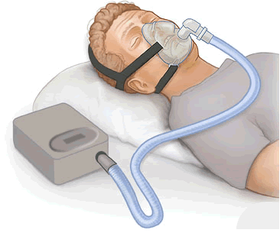Thinking Citizen Blog — Sleep Apnea: Varieties, Prevalence, Compliance
Today’s Topic: Sleep Apnea: Varieties, Prevalence, Compliance
Recently diagnosed with obstructive sleep apnea, I have decided to learn something about it. Apparently, it affects roughly 1 billion people worldwide and about 30% of the elderly. Men are roughly twice as likely to suffer from it as women. Obesity is a major risk factor. The most standard treatment is the CPAP machine but compliance is a serious problem with “more than half of people not appropriately using the device.” “In 2017, only 15% of potential patients in developed countries used CPAP machines, while in developing countries well under 1% of potential patients used CPAP. Without treatment, sleep apnea may increase the risk of heart attack, stroke, diabetes, heart failure, irregular heartbeat, obesity, and motor vehicle collisions.” “Evidence is insufficient to support the use of medications in the treatment of sleep apnea.” Today, a few more notes. Experts — please chime in. Correct, elaborate, elucidate.
WHAT IS SLEEP APNEA? COMES FROM THE GREEK WORD FOR “BREATHLESS” (As soft tissue falls to the back of the throat, it impedes the passage of air (blue arrows) through the trachea) 1. “Sleep apnea is a disorder that causes you to stop breathing while asleep.”
1. “Sleep apnea is a disorder that causes you to stop breathing while asleep.”
2. “Your brain tries to protect you by waking you up enough to breathe, but this prevents restful, healthy sleep.”
3. Obstructive sleep apnea (OSA) involves blockage of the airway. Central sleep apnea (CSA) happens when “your brain doesn’t correctly control your breathing.”
NB: Obstructive sleep apnea accounts for 84% of cases, Central sleep apnea .9%. Mixed 15%.
THE CONTINUOUS POSITIVE AIRWAY PRESSURE (CPAP) MACHINE (includes flow generator, hose, face mask) 1. “With CPAP (SEE-pap), the air pressure is somewhat greater than that of the surrounding air and is just enough to keep your upper airway passages open, preventing apnea and snoring.”
1. “With CPAP (SEE-pap), the air pressure is somewhat greater than that of the surrounding air and is just enough to keep your upper airway passages open, preventing apnea and snoring.”
2. Because of discomfort and inconvenience, 8% of users give up after one night and 50% after one year, Drawbacks include: insomnia, nasal congestion, dry mouth, claustrophobia, nosebleeds, skin irritation, “feeling bloated.”
3. “You might need to try more than one type of mask to find one that’s comfortable. Don’t stop using the CPAP machine if you have problems. Check with your health care provider to see what changes can be made to increase your comfort.”
NB: “Colin Sullivan, an Australian physician and professor, invented CPAP in 1980 at Royal Prince Alfred Hospital in Sydney.” Before Sullivan’s invention, sleep apnea was “was often treated with radical measures such as tracheotomy (incision through the neck into the trachea and the insertion of a breathing tube).”
THE ALZHEIMER’S CONNECTION — the beta-amyloid protein and white-matter damage 1. “Alzheimer’s disease and severe obstructive sleep apnea are connected because there is an increase in the protein beta-amyloid as well as white-matter damage.”
1. “Alzheimer’s disease and severe obstructive sleep apnea are connected because there is an increase in the protein beta-amyloid as well as white-matter damage.”
2. “These are the main indicators of Alzheimer’s, which in this case comes from the lack of proper rest or poorer sleep efficiency resulting in neuro-degeneration.”
3. “Having sleep apnea in mid-life brings a higher likelihood of developing Alzheimer’s in older age, and if one has Alzheimer’s then one is also more likely to have sleep apnea. This is demonstrated by cases of sleep apnea even being misdiagnosed as dementia.”
NB: “With the use of treatment through CPAP, there is a reversible risk factor in terms of the amyloid proteins. This usually restores brain structure and diminishes cognitive impairment.”
Sleep apnea — Wikipedia
Obstructive sleep apnea — Wikipedia
CPAP Machine: What It Is, How It Works, Pros & Cons
Sleep apnea — Diagnosis and treatment — Mayo Clinic
Sleep Apnea: What It Is, Causes, Symptoms & Treatment
Continuous positive airway pressure — Wikipedia
Colin Sullivan (physician) — Wikipedia
Tracheotomy — Wikipedia
The relationship between Obstructive Sleep Apnea and Alzheimer’s Disease
QUOTE OF THE MONTH:
“You’ve got to continue to grow, or you’re just like last night’s corn bread stale and dry.” - Loretta Lynn
ATTACHMENTS BELOW:
#1 A graphic guide to justice (9 metaphors on one page).
#2 “39 Songs, Prayers, and Poems: the Keys to the Hearts of Seven Billion People” — Adams House Senior Common Room Presentation, 11/17/20
LAST FOUR YEARS OF POSTS ORGANIZED THEMATICALLY
PDF with headlines — Google Drive
YOUR TURN
Please share the most interesting thing you learned in the last week related to health, health care or health care policy — the ethics, economics, politics, history…. Or the coolest, most important thing you learned in your life related to health are or health care policy that the rest of us may have missed. Or just some random health-related fact that blew you away.
This is your chance to make some one’s day. Or to cement in your mind something really important you might otherwise forget. Or to think more deeply than you otherwise would about something that matters.






































